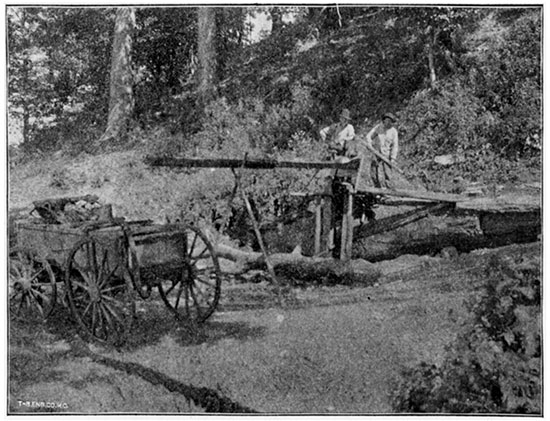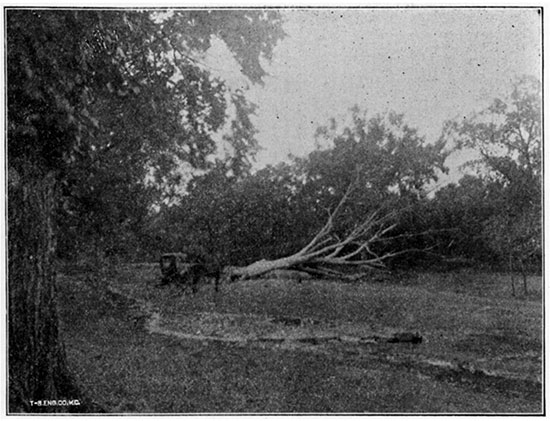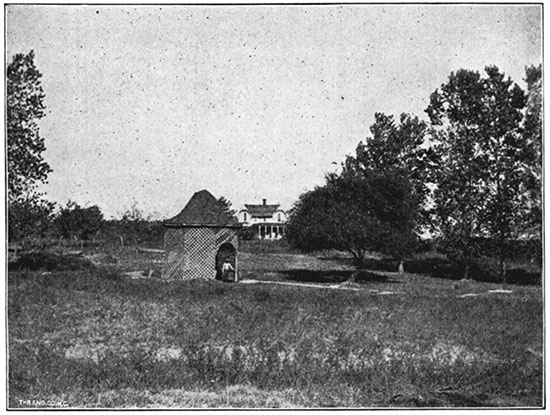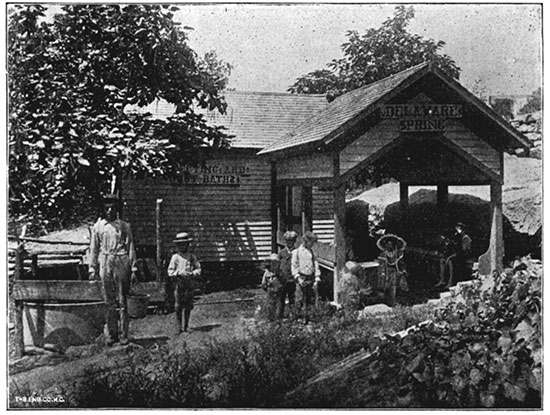Prev Page--Waters of Kansas--Special || Next Page--Waters of Kansas--Geological Distribution
Part II--The Mineral Waters of Kansas, Arranged and Classified, with Analyses, continued
Chapter XVIII--Soft-water Group
These are called by some "indifferent" and by others "neutral" waters. Some of these contain even less than a grain of solid matter to the gallon. They are frequently of great value as therapeutic agents, especially for persons who have been accustomed to drinking hard waters. As stated, in the chapter on therapeutics, often the most important thing about these waters is that they contain so few mineral ingredients.
A good example of this class of waters is that of Pfeffer's Springs, where Martin Luther is said to have spent considerable time, and where he was cured of hypochondriasis. The waters of Wildbad, in Wurtemburg, are of this class. These, we know from Roman remains that have been found in the vicinity, were used even as early as the time of the Caesars.
One reason why such waters are of value in diseases like constipation is, that the patient is induced to drink very large quantities of water, and this not only renders the contents of the Intestines more fluid, but it helps to wash out the body. If the patient was not so situated that. his attention was directed to the drinking of water, he would not use a sufficient quantity.
The diuretic action of large quantities of water is well established. It also increases the quantity of urea, phosphates, chlorids and sulfates that are discharged. If large quantities of water are taken, the temperature of the body falls, and the number of pulsations of the heart and of the inspirations are diminished.
This group is represented by the following waters:
- Atchison, Parker's spring.
- Brookville spring, Saline county.
- Brookville No. 2.
- California spring, Franklin county.
- Cave spring, Galena, (Jasper county, Missouri.)
- Chautauqua, Chautauqua county.
- Chico spring, Galena, Cherokee county.
- Clarus spring, Batesville, Woodson county.
- Conway Springs, Sumner county.
- Delaware springs, Wilson county.
- Linwood spring. Leavenworth county.
- Sand springs, Dickinson county.
Atchison, Parker's Spring
About two miles west of the city of Atchison, on the farm of J. W. Parker, is a fine spring that has been known for many years. It supplies the farm with an abundance of water.
| Parker's Spring Grams per liter |
||||
|---|---|---|---|---|
| Ions | Radicals | |||
| Sodium (Na) | trace | Sodium oxid (Na2O) | trace | |
| Potassium (K) | .0056 | Potassium oxid (K2O) | .0067 | |
| Calcium (Ca) | .0212 | Calcium oxid (CaO) | .0297 | |
| Magnesium (Mg) | .0036 | Magnesium oxid (MgO) | .0060 | |
| Iron (Fe) | .0009 | Iron oxid (FeO) | .0012 | |
| Aluminum (Al) | .0017 | Aluminum oxid (Al2O3) | .0032 | |
| Nitric acid ion (NO3) | .0175 | Nitric anhydrid (N2O5) | .0152 | |
| Chlorin (Cl) | .0063 | Chlorin (Cl) | .0063 | |
| Sulfuric acid ion (SO4) | .0053 | Sulfuric anhydrid (SO3) | .0044 | |
| Phosphoric acid ion (PO4) | trace | Phosphoric anhydrid (P2)O6) | trace | |
| Silicic acid ion (SiO3) | .0253 | Silica (SiO2) | .0200 | |
| Water (H2O) | .0104 | |||
| Carbonic anhydrid (CO2) | .0508 | |||
| Oxygen equivalent | .0014 | |||
| Total | .1525 | |||
Hypothetically combined as follows:
| Grams per liter |
Grains per gallon |
|
|---|---|---|
| Potassium nitrate (KNO3) | .0144 | .8398 |
| Calcium nitrate (Ca(NO3)2) | .0115 | .6686 |
| Calcium bicarbonate (CaH2(CO3)2) | .0745 | 4.3470 |
| Magnesium bicarbonate (MgH2(CO3)2) | .0147 | .8584 |
| Magnesium chlorid (MgCl2) | .0047 | .2727 |
| Iron bicarbonate (FeH2(CO3)2) | .0029 | .1730 |
| Aluminum chlorid (AlCl3) | .0035 | .2030 |
| Aluminum sulfate (Al2(SO4)3) | .0063 | .3657 |
| Silica (SiO2) | .0200 | 1.1666 |
| Totals | .1525 | 8.8948 |
| Temperature 16.6° C. (62° F.) Analysis by E. B. Knerr. |
||
Brookville Spring No. 1
A remarkably pure water from about seven miles west of Brookville has been examined. It is clear, colorless, and of an agreeable taste. It contains only 8.097 grains of solid matter per gallon, which consists of calcium bicarbonate, calcium sulfate, sodium chlorid, with traces of silica, alumina, and magnesium bicarbonate.
Another water from Brookville, which was examined in June, 1887, contains only 3.48 grains per gallon of mineral matter. This consists quite largely of silica, with small quantities of iron and aluminum, and traces of calcium and magnesium bicarbonate, sodium chlorid, and sodium nitrate. This water is remarkably free from mineral. matter, and is in fact one of the purest waters so far noticed in the state. As will be seen, it contains no more mineral matter than waters from the granite and sandstone ledges of the extreme Eastern states.
California Spring, Norwood, Franklin County
This spring is on the farm of E. W. Hume, four miles northwest of Ottawa. It is pleasantly situated on the southern slope of the broad valley of the Marais des Cygnes. The flow is 450 gallons per hour. The California spring is said to have derived its name from its situation on one of the numerous trails leading across the state to the mountains and to California. On the unbroken prairie in the vicinity may still be seen numerous well-marked trails, all converging towards this bountiful water-supply. A few barrels of the water were shipped in 1902. That the water is of exceptional purity may be noticed from the analysis which follows:
| California Spring Grams per liter |
||||
|---|---|---|---|---|
| Ions | Radicals | |||
| Sodium (Na) | .0068 | Sodium oxid (Na2O) | .0092 | |
| Calcium (Ca) | .0146 | Calcium oxid (CaO) | .0205 | |
| Magnesium (Mg) | .0018 | Magnesium oxid (MgO) | .0031 | |
| Iron (Fe) | .0004 | Iron oxid (FeO) | .0005 | |
| Chlorin (Cl) | .0106 | Chlorin (Cl) | .0106 | |
| Sulfuric acid ion(SO4) | 0074 | Sulfuric anhydrid (SO3) | .0062 | |
| Silicic acid ion (SiO3) | .0238 | Silicic anhydrid (SiO2) | .0180 | |
| Carbonic anhydrid (CO2) | .0327 | |||
| Water (H2O) | .0067 | |||
| Oxygen equivalent | .0024 | |||
| Total | .1051 | |||
Hypothetically combined as follows:
| Grams per liter |
Grains per gallon |
|
|---|---|---|
| Sodium chlorid (NaCl) | .0174 | 1.018 |
| Calcium sulfate (CaSO4) | .0106 | .618 |
| Calcium bicarbonate (CaH2(CO3)2) | .0466 | 2.721 |
| Magnesium bicarbonate (MgH2(CO3)2) | .0113 | .661 |
| Iron bicarbonate (FeH2(CO3)2) | .0012 | .071 |
| Silica (SiO2) | .0180 | 1.049 |
| Totals | .1051 | 6.138 |
| Temperature 14.4° C. (58° F.) Analysis by E. H. S. Bailey and D. F. McFarland. |
||
Cave Spring
Northeast of Galena, and on the south side of the ridge near the south bank of Spring creek, is a never-failing spring that is of great advantage to the community. In fact, as the city water at Galena is taken from Shoal creek, which drains the mines of the vicinity, and consequently contains both lead and zinc, this spring furnishes one of the best waters that can be obtained for domestic purposes. The flow is at least 400 gallons per hour. The water is hauled to the city, during the summer especially, for a large number of regular customers. About a quarter of a mile south of this, on the other side of the ridge, is Gum spring, which is also utilized in the same way by the people in the vicinity. Galena is reached by the St. Louis & San Francisco system.
| Cave Spring Grams per liter |
||||
|---|---|---|---|---|
| Ions | Radicals | |||
| Sodium (Na) | .0025 | Sodium oxid Na2O) | .0034 | |
| Calcium (Ca) | .0198 | Calcium oxid (CaO) | .0278 | |
| Magnesium (Mg) | .0016 | Magnesium oxid (MgO) | .0026 | |
| Iron (Fe) | .0028 | Iron oxid (FeO) | .0036 | |
| Chlorin (Cl) | .0028 | Chlorin (Cl) | .0028 | |
| Sulfuric acid ion (SO4) | .0344 | Sulfuric anhydrid (SO3) | .0287 | |
| Silicic acid ion (SiO3) | .0227 | Silicic anhydrid (SiO2) | .0179 | |
| Carbonic anhydrid (CO2) | .0245 | |||
| Water (H2O) | .0049 | |||
| Oxygen equivalent | .0006 | |||
| Total | .1156 | |||
Hypothetically combined as follows:
| Grams per liter |
Grains per gallon |
|
|---|---|---|
| Sodium chlorid (NaCl) | .0046 | .2684 |
| Sodium bicarbonate (NaHCO3) | .0028 | .1634 |
| Calcium sulfate (CaSO4) | .0399 | 2.3321 |
| Calcium bicarbonate (CaH2(CO3)2) | .0328 | 1.9140 |
| Magnesium sulfate (MgSO4) | .0087 | .5081 |
| Iron bicarbonate (FeH2(CO3)2) | .0089 | .5201 |
| Silica (SiO2) | .0179 | 1.0461 |
| Totals | .1156 | 6.7522 |
| Temperature 15° C. (59° F.) Analysis by E. H. S. Bailey and E. McCullom. |
||
Plate 35--Cave Spring, Galena.

Plate 35--Chico Spring, Galena.

Chico Spring
The country in the vicinity of Galena is much diversified and well watered. A mile northwest of this city, in a wooded valley, is the so-called Chico spring. In the high water this spring is covered by the stream, but it ordinarily flows out of the gravel and into the creek. The flow is about 600 gallons an hour in the driest weather. This water contains traces of zinc.
| Chico Spring Grams per liter |
||||
|---|---|---|---|---|
| Ions | Radicals | |||
| Sodium (Na) | .0034 | Sodium oxid (Na2O) | .0046 | |
| Calcium (Ca) | .0458 | Calcium oxid (CaO) | .0642 | |
| Magnesium (Mg) | .0068 | Magnesium oxid (MgO) | .0113 | |
| Iron (Fe) | .0027 | Iron oxid (FeO) | .0035 | |
| Chlorin (Cl) | .0035 | Chlorin (Cl) | .0035 | |
| Sulfuric acid ion (SO4) | .0650 | Sulfuric anhydrid (SO3) | .0544 | |
| Silicic acid ion (SiO3) | .0177 | Silicic anhydrid (SiO2) | .0140 | |
| Carbonic anhydrid (CO2) | .0835 | |||
| Water (H2O) | .0174 | |||
| Oxygen equivalent | .0008 | |||
| Total | .2556 | |||
Hypothetically combined as follows:
| Grams per liter |
Grains per gallon |
|
|---|---|---|
| Sodium chlorid (NaCl) | .0058 | .3384 |
| Sodium bicarbonate (NaHCO3) | .0041 | .2392 |
| Calcium sulphate (CaSO4) | .0448 | 2.6215 |
| Calcium bicarbonate (CaH2(CO3)2) | .1443 | 8.4244 |
| Magnesium (MgSO4) | .0339 | 1.9810 |
| Iron bicarbonate (FeH2(CO3)2) | .0087 | .5080 |
| Silica (SiO2) | .0140 | .8170 |
| Totals | .2556 | 14.9295 |
| Temperature 14.8° C. (58.6° F.) Analysis by E. H. S. Bailey and E. McCullom |
||
Kansas Clarus Spring, Batesville, Woodson County
For description, see chapter XVI.
| Ions | Grams per liter |
|---|---|
| Sodium (Na) | .0315 |
| Calcium (Ca) | .0492 |
| Magnesium (Mg) | .0065 |
| Iron (Fe) | .0005 |
| Chlorin (Cl) | .0052 |
| Sulfuric acid ion (SO4) | .0080 |
| Silicic acid ion (SiO3) | .0085 |
Hypothetically combined as follows:
| Grams per liter |
Grains per gallon |
|
|---|---|---|
| Sodium chlorid (NaCl) | .0087 | .510 |
| Sodium sulfate (Na2SO4) | .0119 | .695 |
| Sodium bicarbonate (NaHCO3) | .0894 | 5.210 |
| Calcium bicarbonate (CaH2(CO3)2) | .1990 | 11.605 |
| Magnesium bicarbonate (MgH2(CO3)2) | .0397 | 2.320 |
| Iron bicarbonate (FeH2(CO3)2) | .0018 | .105 |
| Silica (SiO2) | .0067 | .392 |
| Organic matter | slight trace | slight trace |
| Totals | .3572 | 20.837 |
| Temperature 20° C. (68° F.) Analysis by Church and Lovewell. |
||
Conway Springs, Sumner County
There were originally seven springs in use in this locality, all within a radius of fifty feet, but the use of all but two has been discontinued. One of these flows at the rate of one gallon per minute, with a temperature of 13.8°C. (67° F.), and the other at the rate of one and one-half gallons per minute, with a temperature of 14.4°0. (78°F.) These springs are encased with twenty-four-inch tiling, and are situated in a pavilion about twenty feet square.
They are located in a five-acre park of Russian mulberry and catalpa trees, and there is a lake, covering perhaps half an acre, below the springs.
The water has been used medicinally for years, and much of it is used: in the surrounding county as a table water, but very little has been shipped away. Conway Springs is at a crossing of two lines of the Missouri Pacific railroad.
| Conway Springs Grams per liter |
||||
|---|---|---|---|---|
| Ions | Radicals | |||
| Sodium (Na) | .0038 | Sodium oxid (Na2O) | .0050 | |
| Potassium (K) | .0010 | Potassium oxid (KsO) | .0012 | |
| Calcium (Ca) | .0102 | Calcium oxid (CaO) | .0143 | |
| Magnesium (Mg) | .0022 | Magnesium oxid (MgO) | .0037 | |
| Iron (Fe) | .0012 | Iron oxid (FeO) | .0016 | |
| Chlorin (Cl) | .0036 | Chlorin (Cl) | .0036 | |
| Sulfuric acid ion (SO4) | .0024 | Sulfuric anhydrid (SO3) | .0020 | |
| Phosphoric acid ion (PO4) | .0090 | Phosphoric anhydrid (P2O5) | .0067 | |
| Silica acid ion (SiO3) | .0108 | Silicic anhydrid (SiO2) | .0086 | |
| Carbonic anhydrid (CO2) | .0129 | |||
| Total | .0596 | |||
| Analysis by G. H. Failyer. | ||||
This is a remarkably pure water, and contains only 3.48 grains of mineral matter to the gallon.
Plate 36--Conway Springs.

Plate 36--Delaware Spring.

Delaware Springs
Extending along the western edge of Wilson county and the eastern edge of Elk county is a range of the Chautauqua hills =--bluffs composed of shales and sandstones, and generally covered with scrubby growths of black-jack oak. The sandstones, which are of varying thickness, are composed of coarse grains of sand, loosely cemented, and often occur quite free from iron, as indicated by the white color of the weathered portions. Where such beds can be found of considerable thickness and extent they serve as natural filters and reservoirs, which supply exceptionally pure water to the wells that may be sunk into them and to the many springs that occur in the ravines cutting down through them. This condition exists in typical form about ten miles northwest of Fredonia, in Wilson county, at what is known as the Delaware spring. The hill upon which the spring occurs is about two miles in length from north to south, and from one to two miles in width. At its northern end the hill terminates in a rocky cliff, showing an exposure of perhaps sixty feet of white sandstone. Three-fourths of a mile south of this a ravine runs to the west, and almost at its very head, and upon its northern slope, the spring appears from a fissure in the sandstone. The flow is not great, but is constant throughout the year, at the rate of a gallon in thirty-five seconds. The water is exceptionally pure, clear, and colorless, and possesses the peculiar but not unpleasant taste that characterizes the finest cistern water.
Two or three other springs appear within a few yards of the one described, but nearer the head of the ravine. One of these, though said by the people of the place to produce "softer" water than that from the Delaware spring, yet contains a large quantity of iron, as evidenced by the heavy brown deposit of ferric hydroxide which coats its channel. The springs have been known for the fine quality of their water ever since the settlement of the country. The Delaware Indians are said to have valued them highly, and catch-basins cut in the sloping face of the sandstone, below the springs, are still shown, which are the reputed work of these people. The water was first used for medicinal purposes about 1893, and has been more or less in demand ever since. Some remarkable cures of kidney and stomach troubles are reported to have followed its use. The place has become a resort for people wanting an outing of a few days, and perhaps a half-dozen families make their summer camps under the black oaks in the neighborhood. It is also becoming a popular place for holding camp-meetings, Fourth of July celebrations, and old soldiers' reunions. Stella, the nearest post office to the Delaware springs, may be reached by a drive of ten miles from Fredonia, the county-seat of Wilson county. The latter town is at the crossing of the A. T. & S. F., the M. P. and the St. L. & S. F. railroads.
| Delaware Springs Grams per liter |
||||
|---|---|---|---|---|
| Ions | Radicals | |||
| Sodium (Na) | .0099 | Sodium oxid (Na2O) | .0134 | |
| Potassium (K) | .0055 | Potassium oxid (K2O) | .0067 | |
| Calcium (Ca) | .0124 | Calcium oxid (CaO) | .0143 | |
| Magnesium (Mg) | .0067 | Magnesium oxid (MgO) | .0111 | |
| Iron (Fe) | .0019 | Iron oxid (FeO) | .0025 | |
| Chlorin (Cl) | .0154 | Chlorin (Cl) | .0154 | |
| Sulfuric acid ion (SO4) | .0130 | Sulfuric anhydrid (SO3) | .0109 | |
| Nitric acid ion (NO3) | .0089 | Nitric anhydrid (N2O5) | .0077 | |
| Silicic acid ion (SiO3) | .0219 | Silica (SiO2) | .0173 | |
| Water (H2O) | .0077 | |||
| Carbonic anhydrid (CO2) | .0381 | |||
| Oxygen equivalent | .0034 | |||
| Total | .1417 | |||
Hypothetically combined as follows:
| Grams per liter |
Grains per gallon |
|
|---|---|---|
| Sodium chlorid (NaCl) | .0254 | 1.4836 |
| Potassium nitrate (KNO3) | .0144 | .8411 |
| Calcium sulfate (CaSO4) | .0185 | 1.0805 |
| Calcium bicarbonate (CaH2(CO3)2) | .0194 | 1.1332 |
| Magnesium bicarbonate (MgH2(CO3)2) | .0405 | 2.3656 |
| Iron bicarbonate (FeH2(CO3)2) | .0062 | .3621 |
| Silicate (SiO2) | .0173 | 1.0104 |
| Totals | .1417 | 8.2766 |
| Analysis by E. H. S. Bailey and O. F. Stafford. | ||
Linwood Spring
On the north side of the Kaw river, about ten miles east of Lawrence and a short distance west of Linwood, in the vicinity of the sandstone outcroppings, is a clear, cold spring of pure water upon the McCarrol place. This water contains 9~9 grains of mineral matter to the gallon, which consists of silica, calcium carbonate, calcium sulfate, sodium chlorid, with traces of magnesium carbonate. This is another good example of a "soft" water.
Sand Springs, Dickinson County
These springs are situated near the Smoky Hill river, between two and three miles west of Abilene. The water is utilized as the city supply of Abilene, and is used, on account of its purity, on the dining-cars of the Union Pacific railroad. It is one of the very best city supplies in the state. On evaporation the water leaves only 8.152 grains of mineral matter per gallon. This consists essentially of calcium and magnesium carbonates, calcium sulfate, and sodium chlorid. The specific gravity of the water is 1.001. The water is used in large quantities by the Sand Springs Bottling Works in the manufacture of soda water.
Comparison of Similar Waters
The amount of mineral matter contained in some of the so-called "soft" waters of the world is noted below. In the Appalachian and Green Mountain regions of the United States, where the rocks are granite or sandstone, and where there is frequently very little soil through which the water can percolate, the purest waters are found.
| Grains per gallon | |
|---|---|
| Sheep Rock, Lowell, Mass., artesian well, bored in granite | .81 |
| Paradise spring, Brunswick, Me. | .99 |
| Pownal spring, West Pownal, Me. | 1.15 |
| Pure spring, Cresson, Pa. | 1.26 |
| Pavilion spring, Wernersville, Pa. | 1.98 |
| Holly spring, Woonsocket, R. I. | 2.50 |
| Lechauweki spring, Bethlehem, Pa. | 3.57 |
| Poland spring, South Poland, Me. | 3.76 |
| Jordan, chalybeate, Rockbridge county, Virginia. | 6.45 |
| Tunbridge Wells, England | 7.61 |
| Bareges, France | 10.32 |
| Silurian spring, Waukesha, Wis. | 18.69 |
| Schlangerbad, Germany | 20.46 |
| Aix-les-Bains, France | 25.07 |
| Kansas Waters | ||||
|---|---|---|---|---|
| Conway Springs | 3.41 | Delaware springs | 8.27 | |
| Brookville No. 2* | 3.84 | Parker's | 8.89 | |
| California | 6.13 | Linwood* | 9.90 | |
| Cave spring | 6.75 | Chico spring | 14.92 | |
| Brookville No. 1* | 8.09 | Kansas Clarus | 20.83 | |
| Sand springs* | 8.15 | |||
| * Carbon dioxid to form bicarbonates is not included. | ||||
Prev Page--Waters of Kansas--Special || Next Page--Waters of Kansas--Geological Distribution
Kansas Geological Survey, Geology
Placed on web April 7, 2017; originally published 1902.
Comments to webadmin@kgs.ku.edu
The URL for this page is http://www.kgs.ku.edu/Publications/Bulletins/Vol7/20_soft.html